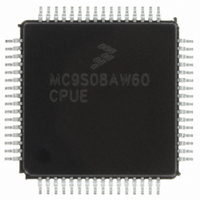MC9S08AW60CPUE Freescale Semiconductor, MC9S08AW60CPUE Datasheet - Page 273

MC9S08AW60CPUE
Manufacturer Part Number
MC9S08AW60CPUE
Description
IC MCU 64K FLASH 64-LQFP
Manufacturer
Freescale Semiconductor
Series
HCS08r
Datasheet
1.MC9S08AW32CFDE.pdf
(324 pages)
Specifications of MC9S08AW60CPUE
Core Processor
HCS08
Core Size
8-Bit
Speed
40MHz
Connectivity
I²C, SCI, SPI
Peripherals
LVD, POR, PWM, WDT
Number Of I /o
54
Program Memory Size
60KB (60K x 8)
Program Memory Type
FLASH
Ram Size
2K x 8
Voltage - Supply (vcc/vdd)
2.7 V ~ 5.5 V
Data Converters
A/D 16x10b
Oscillator Type
Internal
Operating Temperature
-40°C ~ 85°C
Package / Case
64-LQFP
Processor Series
S08AW
Core
HCS08
Data Bus Width
8 bit
Data Ram Size
2 KB
Interface Type
SCI/SPI
Maximum Clock Frequency
40 MHz
Number Of Programmable I/os
54
Number Of Timers
8
Operating Supply Voltage
- 0.3 V to + 5.8 V
Maximum Operating Temperature
+ 85 C
Mounting Style
SMD/SMT
3rd Party Development Tools
EWS08
Development Tools By Supplier
DEMO9S08AW60E
Minimum Operating Temperature
- 40 C
On-chip Adc
16-ch x 10-bit
For Use With
DEMO9S08AW60E - DEMO BOARD FOR MC9S08AW60
Lead Free Status / RoHS Status
Lead free / RoHS Compliant
Eeprom Size
-
Lead Free Status / Rohs Status
Lead free / RoHS Compliant
Available stocks
Company
Part Number
Manufacturer
Quantity
Price
Company:
Part Number:
MC9S08AW60CPUE
Manufacturer:
TDK-LAMBDA
Quantity:
92
Company:
Part Number:
MC9S08AW60CPUE
Manufacturer:
FREESCALE
Quantity:
4 000
Company:
Part Number:
MC9S08AW60CPUE
Manufacturer:
Freescale Semiconductor
Quantity:
10 000
Part Number:
MC9S08AW60CPUE
Manufacturer:
FREESCALE
Quantity:
20 000
Company:
Part Number:
MC9S08AW60CPUER
Manufacturer:
Freescale Semiconductor
Quantity:
10 000
Chapter 15 Development Support
A force-type breakpoint waits for the current instruction to finish and then acts upon the breakpoint
request. The usual action in response to a breakpoint is to go to active background mode rather than
continuing to the next instruction in the user application program.
The tag vs. force terminology is used in two contexts within the debug module. The first context refers to
breakpoint requests from the debug module to the CPU. The second refers to match signals from the
comparators to the debugger control logic. When a tag-type break request is sent to the CPU, a signal is
entered into the instruction queue along with the opcode so that if/when this opcode ever executes, the CPU
will effectively replace the tagged opcode with a BGND opcode so the CPU goes to active background
mode rather than executing the tagged instruction. When the TRGSEL control bit in the DBGT register is
set to select tag-type operation, the output from comparator A or B is qualified by a block of logic in the
debug module that tracks opcodes and only produces a trigger to the debugger if the opcode at the compare
address is actually executed. There is separate opcode tracking logic for each comparator so more than one
compare event can be tracked through the instruction queue at a time.
15.3.5
Trigger Modes
The trigger mode controls the overall behavior of a debug run. The 4-bit TRG field in the DBGT register
selects one of nine trigger modes. When TRGSEL = 1 in the DBGT register, the output of the comparator
must propagate through an opcode tracking circuit before triggering FIFO actions. The BEGIN bit in
DBGT chooses whether the FIFO begins storing data when the qualified trigger is detected (begin trace),
or the FIFO stores data in a circular fashion from the time it is armed until the qualified trigger is detected
(end trigger).
A debug run is started by writing a 1 to the ARM bit in the DBGC register, which sets the ARMF flag and
clears the AF and BF flags and the CNT bits in DBGS. A begin-trace debug run ends when the FIFO gets
full. An end-trace run ends when the selected trigger event occurs. Any debug run can be stopped manually
by writing a 0 to ARM or DBGEN in DBGC.
In all trigger modes except event-only modes, the FIFO stores change-of-flow addresses. In event-only
trigger modes, the FIFO stores data in the low-order eight bits of the FIFO.
The BEGIN control bit is ignored in event-only trigger modes and all such debug runs are begin type
traces. When TRGSEL = 1 to select opcode fetch triggers, it is not necessary to use R/W in comparisons
because opcode tags would only apply to opcode fetches that are always read cycles. It would also be
unusual to specify TRGSEL = 1 while using a full mode trigger because the opcode value is normally
known at a particular address.
The following trigger mode descriptions only state the primary comparator conditions that lead to a trigger.
Either comparator can usually be further qualified with R/W by setting RWAEN (RWBEN) and the
corresponding RWA (RWB) value to be matched against R/W. The signal from the comparator with
optional R/W qualification is used to request a CPU breakpoint if BRKEN = 1 and TAG determines
whether the CPU request will be a tag request or a force request.
MC9S08AW60 Data Sheet, Rev 2
Freescale Semiconductor
273











